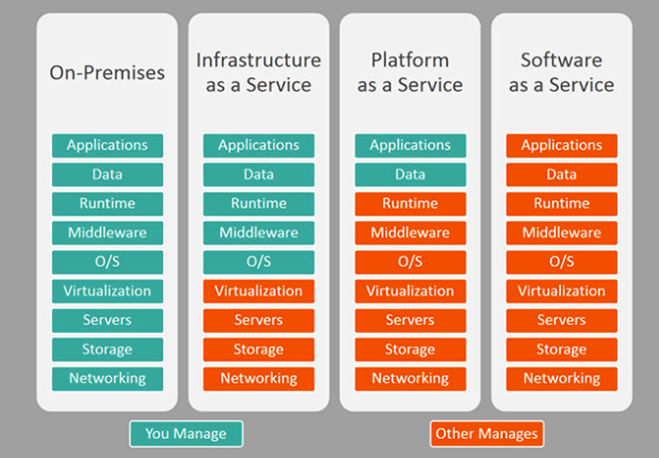# Topic covered
* Cloud computing and types
* Software as a Service(SaaS)
* Platform as a Service(Paas)
* Infrastructure as a Service(IaaS)
* Why cloud computing?
1.1 What is Cloud computing?
Cloud Computing is a remote virtual pool of on-demand shared resources offering compute, storage, database,
and network services that can be rapidly deployed at scale.
# Types of Cloud Computing
* Software as a Service(SaaS)
* Platform as a Service(Paas)
* Infrastructure as a Service(IaaS)

Software as a Service(SaaS)
- SaaS model provides cloud-based tools and applications to consumers and businesses
- SaaS helps you to eliminate the need to have IT staff download and install applications on each computer
- SaaS model is used by end users
- Eg:
Google Docs,Microsoft’s Office 365 online, etc
Platform as a Service(Paas)
- PaaS model allows them to host, manage, and secure their own applications
- PaaS provides freedom to build the software without the need to worry about software updates
- PaaS is the set of tools and services designed to make
coding and deployingthose applicationsquick and efficient - Eg:
Heroku,AWS Lambda - Elastic Beanstalk
- https://docs.aws.amazon.com/elasticbeanstalk/latest/dg/Welcome.html
- End-to-end web application management
- Deploy app on EC2
Infrastructure as a Service(IaaS)
- IaaS allows organizations to manage their business resources like network, server, and data storage.
- IaaS delivers cloud computing infrastructure through virtualization technology.
- EG: AWS EC2, Azure, and GCP
- CloudFormation
- https://docs.aws.amazon.com/AWSCloudFormation/latest/UserGuide/Welcome.html
- Create and Manage Resources with Templates
1.2 Why cloud computing?
Scalability,high availability,disaster recovery,serverless, etc.—that make cloud computing such a powerful service.Cost Savings- No Physical hardware required for –> Computing, Storage, Database
Pay-as-you-go- Use fewer resources –> Pay-less
- Upgrade resources –> Pay according to requirement
Security- Data security is one of the biggest advantages of cloud computing.
- Cloud offers many advanced features related to security and ensures that data is securely stored and handled.
Loss Prevention- No risk of losing data, Various copies are stored on the cloud
- Once the data is stored in the cloud, it is easier to get back up and restore that data using the cloud.
AWS Introduction
- Amazon Web Services (AWS) is a comprehensive
cloud computing platform - It includes
infrastructure as a service (IaaS)andplatform as a service (PaaS)offerings. - Designed a doc in 2003
- 2004: SQS stands for “Simple Queue Service” and was officially launched in 2004
- 2006: AWS launched
Advantages of AWS
- Flexibility
- AWS does not require learning new technologies
- Cost-effectiveness
- No upfront investment
Pay-As-You-Go
- Scalability
- Autoscaling and elastic load balancing techniques are automatically scaled up or down when demand increases or decreases respectively.
- Security
- AWS provides end-to-end security and privacy to customers.
AWS Services
Compute Service
- Amazon EC2
- Amazon Elastic Beanstalk
- Amazon Lambda
- Auto Scaling
- Elastic Load Balancer
Storage and Content Delivery service
- Amazon EBS
- Amazon EFS
- Amazon S3
- Amazon Glacier
- AWS Snowball
Database Services
- RDS
- Amazon DynamoDB
- Amazon ElasticCache
- Amazon Redshift
Networking Services
- Amazon VPC
- Amazon Route 53
- AWS Direct Connect
Management Tools
- Amazon CloudWatch
- Amazon CloudTrail
- AWS OpsWorks
- AWS Trusted Advisor
- AWS CloudFormation
Security & Identity
- AWS Identity Access Management (IAM)
- AWS key management services (KMS)
Application Services
- Amazon SES
- Amazon SNS
- Amazon SQS
- AWS SWF
Developer Tools
- CodePipeline
- CodeDeploy
- CodeBuild
- CodeCommit
AWS Services Trail info
- AWS Free Tier
- AWS provides free tier usage of their services
Amazon S3
12 MONTHS FREE- 5 GB of Standard Storage
- 20,000 Get Requests
- 2,000 Put Requests
Amazon EC2
12 MONTHS FREE- 750 hours per month of Linux, RHEL, or SLES t2.micro or t3.micro instance dependent on region
- 750 hours per month of Windows t2.micro or t3.micro instance dependent on region
Amazon Elastic Block Store
- AWS Free Tier includes 30 GB of storage,
- 2 million I/Os,
- 1 GB of snapshot storage with Amazon Elastic Block Store (EBS).
Amazon Elastic File System
- 5 GB of standard storage
- for 12 months with the AWS Free Tier
Amazon Redshift
2 Month free trial- 750 hours per month for 2 months
- DC2.Large node with 160 GB of compressed SSD storage
Amazon RDS
12 MONTHS FREE- Each calendar month
- 750 hrs of Amazon RDS in a Single-AZ db.t2.micro Instance.
- 20 GB of General Purpose (SSD) database storage
- 20 GB of storage for database backups and DB Snapshots
AWS CloudFront
Always freewith Each month- 1 TB of data transfer out
- 10,000,000 HTTP or HTTPS Requests
- 2,000,000 CloudFront Function Invocations
Elastic Load Balancing
- 750 hours free per month
- 15 GB of data processing for Classic load balancers
- 15 LCUs for Application Load Balancers.







